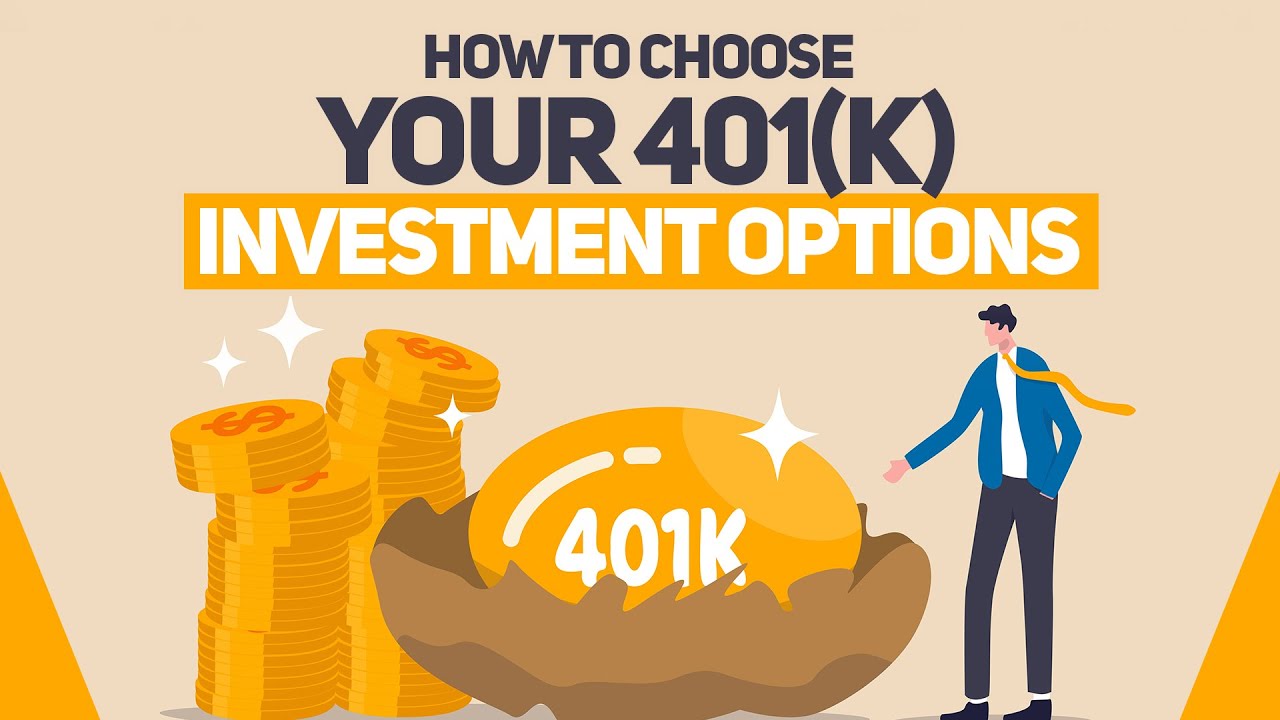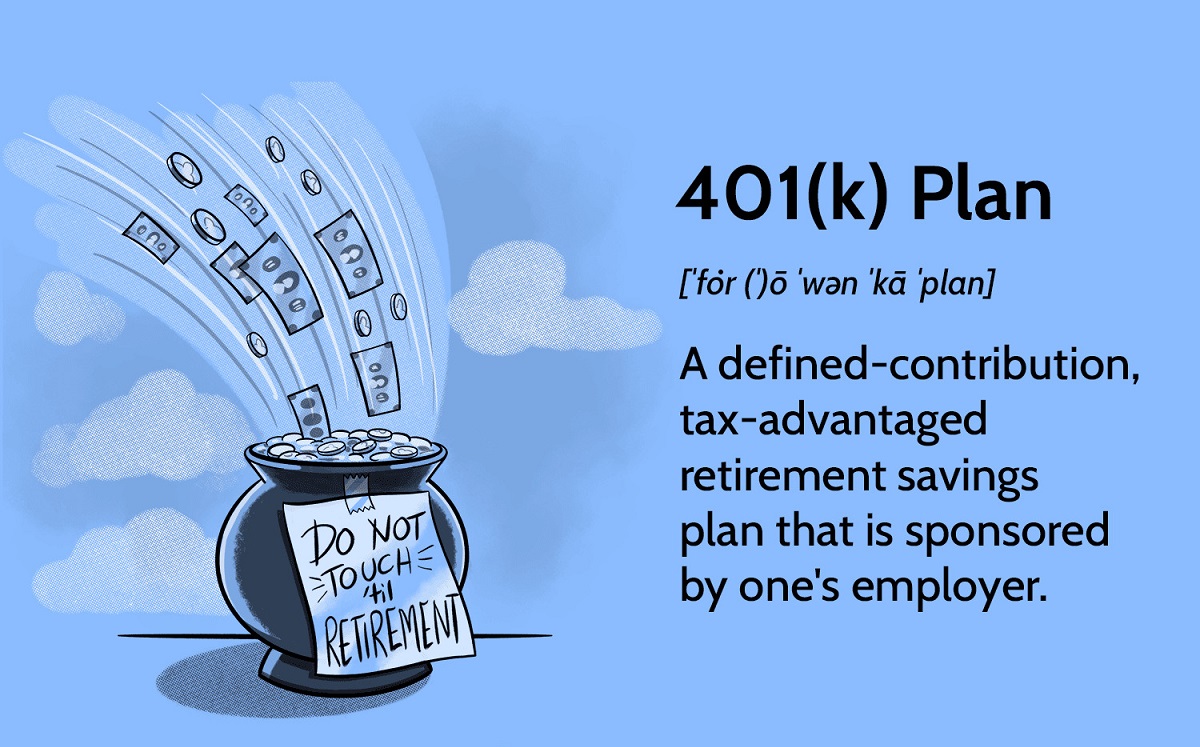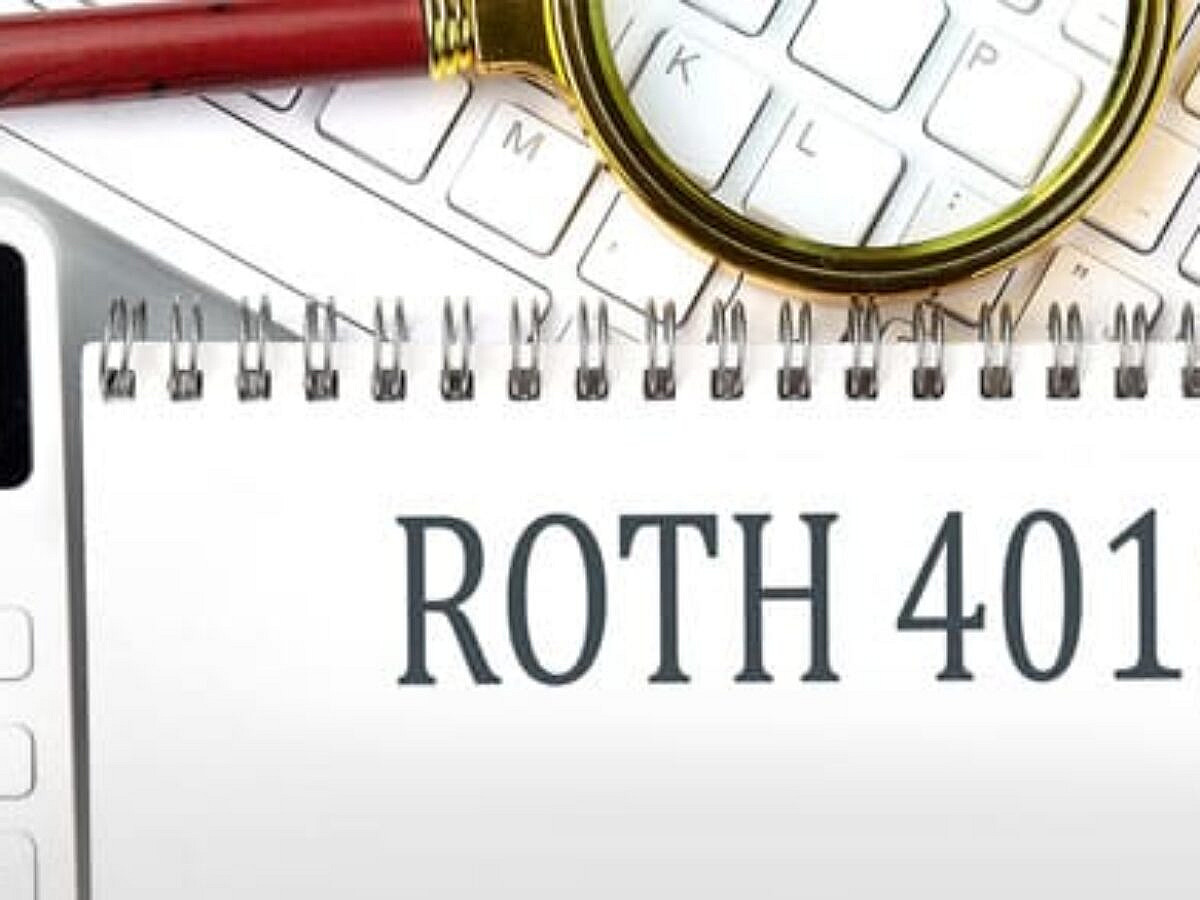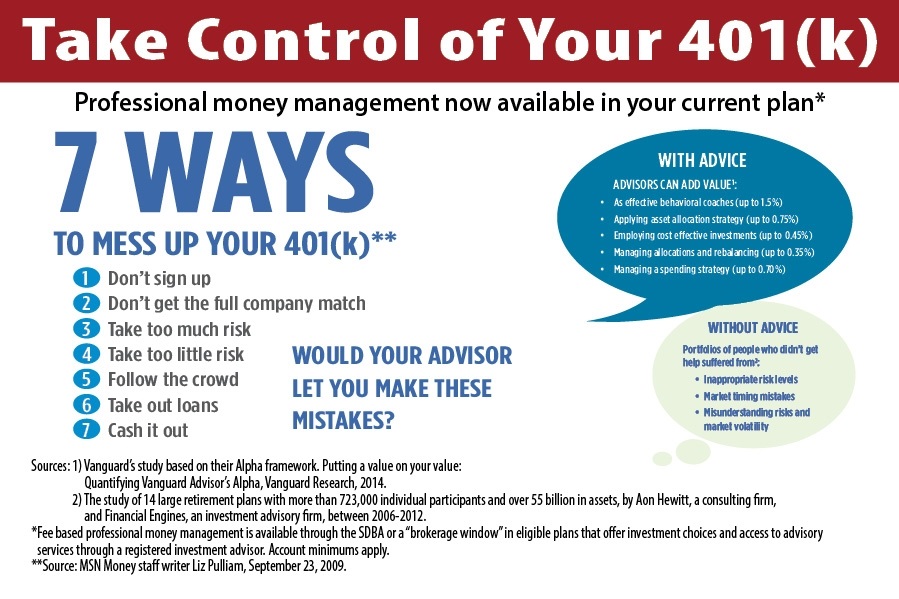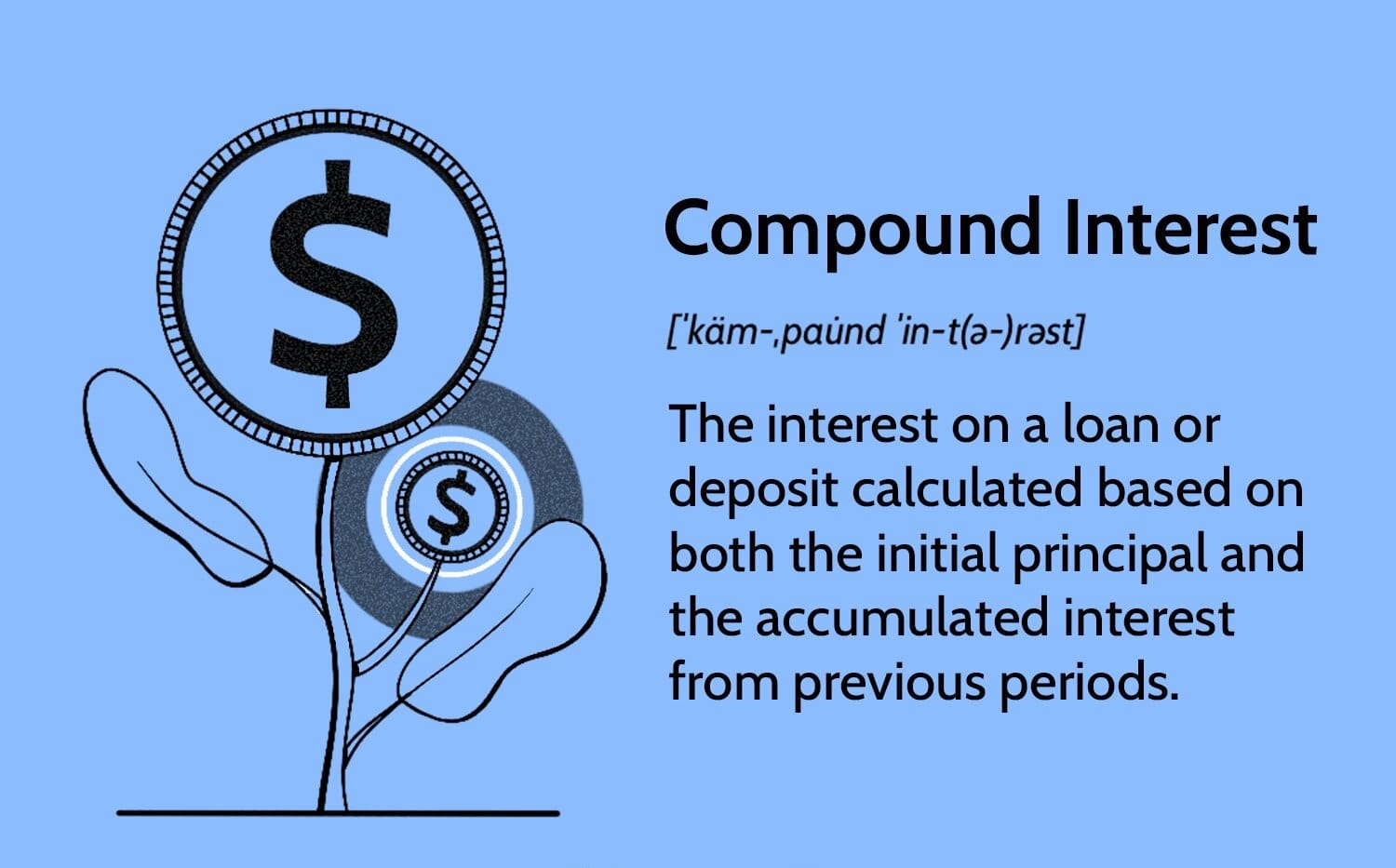Introduction
When it comes to planning for retirement, one essential component is choosing the right investments for your 401(k) account. Your 401(k) plan offers a range of investment options that allow you to grow your retirement savings over time. However, with so many investment choices available, it can be overwhelming to determine which ones are best suited for your individual needs and goals.
In this article, we will guide you through the process of selecting 401(k) investments. We’ll cover various factors to consider, including your risk tolerance, investment research, expense ratios, historical performance, diversification, asset allocation, active vs. passive investing, and the importance of rebalancing. By the end, you’ll gain a better understanding of how to make informed investment decisions for your retirement savings.
Before we delve into the details, it’s important to emphasize that every individual’s financial goals and risk tolerance differ. The information provided in this article is of a general nature and should not be considered as financial advice. It’s always recommended to consult with a qualified financial advisor who can help tailor a 401(k) investment strategy specifically for your unique circumstances.
So, are you ready to embark on the journey of picking the right investments for your 401(k) account? Let’s dive in and explore the key considerations that will help you make sound investment decisions to support your retirement goals.
Understanding 401(k) Investments
A 401(k) investment is a retirement savings account provided by employers that allows employees to contribute a portion of their salary on a pre-tax basis. These contributions are then invested in a variety of investment options, such as mutual funds, stocks, bonds, or target-date funds.
One of the key advantages of a 401(k) investment is the potential for tax deferral. This means that the contributions and any investment gains within the account are not taxed until you withdraw the funds during retirement. This can provide significant tax advantages and allow your savings to grow more rapidly over time.
It’s essential to understand that 401(k) investments come with risks. The value of your investments can fluctuate based on market conditions, and there is no guarantee of returns. However, by carefully selecting your investments, you can minimize risks and maximize long-term growth potential.
When considering 401(k) investments, one of the first factors to consider is your risk tolerance. Your risk tolerance reflects your comfort level with taking on investment risk to potentially achieve higher returns. If you have a higher risk tolerance, you may be more willing to invest in assets with higher volatility, such as stocks. On the other hand, if you have a lower risk tolerance, you may lean towards more conservative investments, such as bonds or money market funds.
Another important factor to consider is your time horizon until retirement. The longer your time horizon, the more time your investments have to potentially grow. This allows for a more aggressive investment approach. Conversely, if you are closer to retirement, you may want to focus on preserving capital and choose more conservative investment options.
Lastly, it’s crucial to consider your investment knowledge and comfort level with managing your own investments. Some individuals may prefer a hands-on approach and enjoy researching and selecting individual investments. Others may prefer a more hands-off approach and opt for professionally managed funds, such as target-date funds.
By understanding these fundamental aspects of 401(k) investments, you can make informed decisions that align with your goals, risk tolerance, and investment preferences. In the next sections, we will delve deeper into the various factors to consider when selecting specific investments for your 401(k) account.
Assessing Your Risk Tolerance
Assessing your risk tolerance is a crucial step in selecting 401(k) investments. Your risk tolerance reflects your comfort level with taking on investment risk to potentially achieve higher returns. It is influenced by factors such as your financial goals, time horizon, and personal preferences.
To assess your risk tolerance, start by considering your financial goals. Are you aiming for aggressive growth or more stable, conservative returns? If your primary objective is to grow your retirement savings quickly, you may be more comfortable with a higher level of risk. However, if your goal is capital preservation with less volatility, a more conservative investment strategy may be appropriate.
Next, evaluate your time horizon until retirement. Generally, the longer your time horizon, the more risk you can afford to take. This is because you have more time to recover from any short-term market volatility and potentially benefit from long-term growth. However, if you are nearing retirement, a sudden market downturn could significantly impact your savings, so you may want to adjust your risk exposure accordingly.
Consider your emotional response to market turbulence as well. If you tend to get anxious or stressed when markets fluctuate, you may be more comfortable with a lower risk portfolio. On the other hand, if you have a higher tolerance for market volatility and feel confident in your ability to weather short-term fluctuations, you may be willing to take on more risk.
It’s important to note that risk tolerance is not a static concept and may evolve over time. As you approach retirement or experience changes in your financial situation, you may need to re-evaluate your risk tolerance and adjust your investment strategy accordingly.
There are also tools and questionnaires available that can help you assess your risk tolerance. These assessments typically consist of a series of questions about your financial goals, time horizon, and risk preferences. The results provide guidance on which investment options may be suitable for your risk tolerance level.
Remember, while assessing your risk tolerance is an important step, it’s equally essential to strike a balance between risk and potential returns. Avoid being either too conservative, which may result in slow growth, or too aggressive, which could expose you to significant market fluctuations. By understanding your risk tolerance, you can make more informed decisions when selecting investments that align with your goals and comfort level.
Researching Available Investment Options
Once you have assessed your risk tolerance, the next step in selecting 401(k) investments is to research the available options within your retirement plan. Most 401(k) plans offer a range of investment choices, including mutual funds, stocks, bonds, and target-date funds.
Start by reviewing the investment menu provided by your employer’s retirement plan. This menu will outline the available investment options along with essential information, such as the fund’s name, investment objective, historical performance, and expense ratio. Take the time to familiarize yourself with each available option.
Consider the investment objective of each fund. Some funds may focus on growth and capital appreciation, while others may prioritize income generation or capital preservation. Aligning the fund’s objective with your own financial goals and risk tolerance is crucial.
Review the historical performance of each available investment option. While past performance does not guarantee future results, it can provide insights into how the fund has performed in different market conditions. Look for consistent, long-term performance rather than focusing on short-term fluctuations.
Pay attention to the expense ratios of the funds. The expense ratio represents the annual cost of owning the fund, expressed as a percentage of your investment. Lower expense ratios are generally preferable as they reduce the impact on your overall returns. Compare expense ratios among similar funds to identify those with more competitive fees.
Explore the fund’s holdings and diversification. A well-diversified fund will invest in a variety of asset classes, such as stocks, bonds, and cash. Diversification helps to spread risk across different investments, reducing the impact of a single investment’s performance on your overall portfolio. Evaluate how each fund’s asset allocation aligns with your own investment goals and risk tolerance.
Additionally, consider the fund manager’s experience and track record. The fund manager plays a crucial role in the fund’s performance. Look for experienced managers with a consistent and successful investing history.
Beyond the information provided in the retirement plan’s investment menu, take advantage of additional resources. Conduct independent research using reputable financial websites, read fund prospectuses, and consider consulting with a financial advisor or investment professional for personalized guidance.
Remember, the goal is to select a diversified portfolio of investments that align with your risk tolerance and financial goals. By thoroughly researching the available investment options within your 401(k) plan, you can make informed decisions to build a well-rounded investment portfolio.
Evaluating Expense Ratios
Expense ratios play a significant role in selecting 401(k) investments. The expense ratio represents the annual cost of owning a mutual fund or other investment, expressed as a percentage of your investment. It includes management fees, administrative expenses, and other operating costs associated with the fund.
When evaluating expense ratios, lower is generally better. A lower expense ratio can have a meaningful impact on your long-term investment returns. Even a small difference in expenses can compound over time and significantly reduce the overall growth of your retirement savings.
To evaluate expense ratios effectively, start by comparing the ratios among similar funds within your 401(k) plan. Different funds may have varying expense structures, so it’s essential to assess them within the context of their respective categories. For example, compare the expense ratios of large-cap equity funds to other large-cap equity funds.
Consider the historical performance of the funds in relation to their expense ratios. Evaluate whether higher-cost funds consistently outperform lower-cost funds over time. While past performance does not guarantee future results, this analysis can help you gauge the value provided by the higher expense ratio funds.
It’s worth noting that the relationship between expense ratios and performance can vary across different asset classes. In some asset classes, such as actively managed funds, higher expense ratios may be justified if the fund consistently outperforms its benchmark index. However, in other asset classes, lower-cost index funds may be more suitable due to their broad market exposure and potential to match the performance of the underlying index.
Consider the impact of compounding on your retirement savings. Over the long term, even a small difference in expense ratios can result in a significant difference in accumulated wealth. By minimizing expenses, you can keep more of your investment returns working for you and potentially improve your retirement nest egg.
While expense ratios are an essential factor to consider, they should not be the sole determinant in your investment decision-making process. Other factors, such as investment objective, historical performance, and risk tolerance, should also be taken into account. It’s important to strike a balance between low expenses and investments that align with your long-term goals.
Lastly, periodically review the expense ratios of your investment holdings. Expense ratios can change over time, and funds with higher costs may lose their competitive edge. Staying vigilant and regularly assessing your investment expenses can help you optimize your retirement savings strategy.
By evaluating expense ratios and selecting funds with lower fees, you can potentially enhance your long-term investment returns and make your 401(k) savings work harder for you.
Examining Historical Performance
Examining the historical performance of investment options is an essential step in selecting 401(k) investments. While past performance cannot guarantee future results, analyzing historical performance can provide insights into how investments have performed in different market conditions.
When evaluating historical performance, consider the timeframe over which the performance is measured. Longer-term performance is generally more informative than short-term performance. Look for consistency in performance over several years to identify investment options that have demonstrated long-term success.
Compare the performance of investment options to relevant benchmark indices. Benchmark indices represent the performance of a specific market segment or asset class. By comparing investment returns to benchmark returns, you can assess whether the funds outperformed or underperformed their respective benchmarks.
Avoid focusing solely on funds that have recently performed exceptionally well. Short-term performance can be influenced by various factors, including market conditions and investment strategies. It’s essential to assess performance consistently over multiple market cycles to gauge the fund’s resilience in different market environments.
Consider the risk-adjusted returns of the investment options. Some investments may deliver high returns but may also come with higher levels of volatility. Assessing risk-adjusted returns helps you determine how effectively a fund has managed risk while generating returns. One common measure of risk-adjusted performance is the Sharpe ratio, which indicates the excess return of a fund compared to its volatility.
Look for investment options with a track record of consistent, long-term performance. Funds that have consistently outperformed their benchmarks over an extended period may indicate a well-managed portfolio or a successful investment strategy. However, keep in mind that past performance is not a guarantee of future success.
Remember that it’s crucial to consider the investment options in the context of your own risk tolerance and investment goals. Some investment options may be inherently riskier but offer the potential for higher returns. Assess whether the historical performance aligns with your risk tolerance and financial objectives.
Keep in mind that historical performance should be evaluated alongside other factors such as expense ratios, fund management, and diversification. A comprehensive analysis of all relevant factors will provide a more informed perspective when selecting 401(k) investments.
Finally, it’s important to note that historical performance is just one piece of the puzzle. It should be used as a tool for analysis and comparison rather than the sole basis for investment decision-making. Regularly monitor the performance of your investments and make adjustments as necessary to ensure they continue to align with your long-term goals.
By examining the historical performance of investment options, you can gain insights into how they have performed over time and make more informed decisions when selecting investments for your 401(k) account.
Diversification and Asset Allocation
Diversification and asset allocation are fundamental concepts to consider when selecting 401(k) investments. These strategies help spread your investment risk and optimize your portfolio’s potential for returns.
Diversification involves investing in a variety of different asset classes, such as stocks, bonds, and cash equivalents. The goal is to reduce the impact of any single investment’s poor performance on your overall portfolio. By diversifying, you can potentially achieve a more balanced risk-return profile.
Asset allocation refers to the proportion of your portfolio allocated to different asset classes. It is based on your risk tolerance, time horizon, and financial goals. Asset allocation is typically divided between stocks, bonds, and cash, with the allocation percentages adjusted based on individual circumstances.
When considering asset allocation, it’s important to understand that different asset classes have unique risk and return characteristics. Stocks are known for their higher potential returns, but they also come with increased volatility. Bonds offer stability and income, but their returns may be lower. Cash equivalents provide stability and immediate liquidity but may generate minimal returns.
Finding the right asset allocation depends on your risk tolerance and investment objectives. Younger individuals with a longer time horizon may opt for a more aggressive allocation weighted towards stocks to maximize growth potential. Those closer to retirement may lean towards a more conservative allocation with a higher emphasis on income and capital preservation.
In addition to asset allocation, consider diversifying within each asset class. For example, if investing in stocks, diversify across different industries, market sizes, and geographic regions. This can further reduce your exposure to single-company or sector-specific risk.
Regularly review and rebalance your portfolio to maintain your desired asset allocation. Over time, the performance of different asset classes will vary, causing your portfolio to deviate from your intended allocation. Rebalancing involves selling or buying assets to bring your portfolio back in line with your target allocation. This ensures that you’re not overly exposed to any one asset class and helps maintain the desired risk and return profile of your investments.
Asset allocation and diversification are not one-time decisions; they are ongoing processes. As your circumstances change and as market conditions fluctuate, you may need to adjust your allocation to align with your evolving goals and risk tolerance.
It’s worth noting that diversification and asset allocation do not guarantee profits or protect against losses. However, they can help mitigate risk and potentially generate more consistent returns over the long term.
By implementing a diversified portfolio and appropriate asset allocation, you can minimize risk, maximize returns, and build a well-balanced investment strategy within your 401(k) account.
Bond Funds vs. Stock Funds
When considering 401(k) investments, one important decision is choosing between bond funds and stock funds. Bond funds and stock funds represent different asset classes with distinct risk and return characteristics. Understanding the differences between these options can help you make an informed decision based on your risk tolerance and investment objectives.
Bond funds invest in fixed-income securities such as government bonds, corporate bonds, municipal bonds, or Treasury Inflation-Protected Securities (TIPS). These funds provide regular income in the form of interest payments and are generally considered to have lower volatility compared to stocks. Bond funds are often favored by investors seeking income, capital preservation, or a more conservative investment approach.
Stock funds, on the other hand, invest in a portfolio of stocks or equity securities. These funds offer the potential for higher long-term returns but also come with increased volatility. Stock funds are well-suited for investors with a higher risk tolerance and a longer time horizon who seek capital appreciation and growth potential in their portfolios.
When deciding between bond funds and stock funds, consider your risk tolerance and time horizon. Bond funds tend to have lower risk and potentially lower returns compared to stock funds. If you have a low risk tolerance and a shorter time horizon, bond funds may be a more suitable option to preserve capital and generate income.
Stock funds carry a higher level of market risk due to stock price fluctuations. However, over the long term, stocks have historically outperformed bonds in terms of total return. If you have a higher risk tolerance and a longer time horizon, stock funds may offer the potential for higher growth and long-term wealth accumulation.
It’s important to note that diversification is essential within both bond and stock funds. Within bond funds, diversify across different types of bonds and issuers to reduce credit and interest rate risk. In stock funds, diversify across different sectors, industries, and market sizes to minimize exposure to any single company or market segment.
Consider your investment goals and the overall composition of your portfolio. A well-rounded portfolio may include a mix of both bond funds and stock funds to achieve a balanced risk-return profile. This strategy allows for potential growth from stocks while providing stability and income from bond investments.
Lastly, keep in mind that your asset allocation and investment strategy should align with your specific financial goals and risk tolerance. It’s recommended to seek advice from a qualified financial professional who can help assess your unique circumstances and recommend suitable investments based on your individual needs.
By understanding the characteristics and differences between bond funds and stock funds, you can make an informed decision to construct a well-diversified portfolio that aligns with your risk tolerance, time horizon, and investment objectives within your 401(k) account.
The Importance of Rebalancing
Rebalancing is a crucial aspect of managing your investment portfolio within a 401(k) account. It involves periodically adjusting your asset allocation to maintain your desired risk and return profile. Rebalancing ensures that your investments stay aligned with your long-term goals, and it can help protect your portfolio from becoming overexposed to certain asset classes.
Over time, market fluctuations can cause your portfolio’s asset allocation to shift. For example, if stocks outperform bonds over a specific period, the equity proportion of your portfolio may increase. Rebalancing involves selling some of the overweight asset class (stocks) and buying more of the underweight asset class (bonds) to restore your desired allocation.
The primary goal of rebalancing is to control risk. By selling assets that have performed well and buying assets that have underperformed, you are essentially selling high and buying low. This disciplined approach helps you avoid chasing returns and reduces the potential for significant losses due to overexposure to a single asset class.
Rebalancing also enforces the principles of buying low and selling high. When certain asset classes have experienced significant gains, it may be an opportune time to sell some of those holdings to capture profits. Conversely, when other asset classes have declined, it may be an advantageous time to add to those positions at a lower cost.
Rebalancing can help you maintain your desired level of risk. If you have a conservative investment approach and your portfolio becomes too heavily weighted towards riskier assets like stocks, rebalancing can help restore your intended allocation and reduce exposure to potential market downturns.
It’s important to establish a rebalancing schedule based on your investment strategy and risk tolerance. Some investors choose to rebalance on a quarterly or yearly basis, while others rebalance when their portfolio significantly deviates from their target allocation. The right frequency depends on your individual circumstances and preferences.
Automating the rebalancing process can make it easier to follow through. Many 401(k) plans offer automatic rebalancing features that enable you to set a target allocation and have the account rebalanced automatically at regular intervals. This can help you stay disciplined and avoid the temptation to make emotional investment decisions based on short-term market fluctuations.
Rebalancing is a critical component of long-term investment success. It allows you to maintain your desired asset allocation, control risk exposure, and potentially enhance your portfolio’s overall performance. By periodically reassessing and adjusting your investments, you help ensure that your 401(k) account remains aligned with your financial goals throughout your investment journey.
Active vs. Passive Investments
When selecting 401(k) investments, you will encounter two primary investment approaches: active and passive management. These approaches differ in how they aim to generate returns and manage portfolios, and understanding the differences between them can inform your investment decision-making.
Active management involves professional fund managers actively making investment decisions with the goal of outperforming a benchmark index or peer group. Active managers conduct research and analysis to select individual stocks or bonds they believe will generate superior returns. They also actively trade securities based on market conditions and their investment outlook.
Passive management, also known as index investing, aims to replicate the performance of a specific market index, such as the S&P 500 or the Bloomberg Barclays US Aggregate Bond Index. Passive managers use a “buy and hold” strategy, maintaining a portfolio that mirrors the composition of the selected index. They do not attempt to outperform the market; instead, they seek to match its performance.
One primary difference between active and passive investing is cost. Active management tends to have higher expense ratios due to the costs associated with research, trading, and the expertise of active managers. In contrast, passive funds have lower expense ratios since they do not require extensive research or frequent trading.
Performance is another key consideration. Active managers aim to outperform their benchmark index. However, research suggests that many active managers fail to consistently outperform over the long term, and their performance can be unpredictable. Passive funds, on the other hand, tend to closely track the performance of their respective index, providing investors with broad market exposure.
Risk is also a factor to consider. Active management involves the risk that the selected investments may underperform or the manager’s investment decisions may not achieve the desired results. With passive management, the risk lies in the overall performance of the market index being tracked.
Investor preferences and beliefs can also influence the decision between active and passive management. Some investors have confidence in the ability of active managers to identify mispriced securities and achieve superior returns. Others prefer the simplicity, lower costs, and the belief that markets are efficient and difficult to consistently beat, leading them towards passive index investing.
Both active and passive approaches have their merits and drawbacks, and the best choice depends on your investment goals, risk tolerance, and personal beliefs. Some investors opt for a combination of both approaches, using passive investments for core holdings and supplementing with actively managed funds that align with their investment strategies.
Before making a decision, consider factors such as cost, performance, risk, and your own investment philosophy. It can also be beneficial to review historical performance and compare metrics such as expense ratios and fund manager track records when evaluating specific investment options.
Regardless of the approach chosen, regularly monitoring and reviewing your 401(k) investments is crucial to ensure they continue to align with your financial goals and objectives.
Target-Date Funds as an Option
Target-date funds are a popular investment option within 401(k) plans, especially for individuals who prefer a hands-off approach to investing. These funds are designed to automatically adjust their asset allocation based on the target retirement date specified by the investor.
Target-date funds offer a diversified portfolio of investments that typically include a mix of stocks, bonds, and cash equivalents. The allocation starts with a higher percentage of stocks in the early years, gradually shifting towards a higher allocation of bonds and cash equivalents as the target retirement date approaches. This asset allocation adjustment is referred to as the fund’s “glide path.”
One of the key advantages of target-date funds is their simplicity. They provide a one-stop solution for investors, eliminating the need to select and manage individual investments. This makes them an attractive option for those who may be unfamiliar with investing or prefer to take a more hands-off approach.
Target-date funds offer convenience and automatic rebalancing. As the fund’s target date gets closer, the asset allocation automatically adjusts, reducing the risk exposure to potentially more volatile assets, such as stocks. This feature helps mitigate the impact of market fluctuations as you approach retirement.
It’s important to note that target-date funds are not one-size-fits-all solutions. Different fund providers have varying asset allocation strategies and glide paths, leading to differences in risk and return profiles. It’s crucial to review the fund’s prospectus and understand its investment strategy and underlying holdings.
Consider your risk tolerance and investment objectives when selecting a target-date fund. Some investors may prefer funds with a more aggressive glide path that maintains a higher allocation to stocks for longer periods, aiming for higher potential returns. Others may opt for funds with a more conservative glide path, prioritizing capital preservation and stable income as retirement nears.
While target-date funds offer simplicity and convenience, they are not without limitations. They may have higher expense ratios compared to individual index funds since they incorporate management fees to adjust the asset allocation over time. Additionally, they do not consider individual factors such as your specific risk tolerance, other investment accounts, or individual financial circumstances.
It’s important to regularly review and reassess your target-date fund to ensure it continues to align with your goals. Changes in your financial situation or risk tolerance may warrant a different asset allocation strategy. Additionally, comparing the performance and expense ratios of target-date funds from different providers can help you make an informed selection.
Target-date funds can be a suitable option for investors seeking a simplified and diversified approach to retirement investing. However, it’s important to carefully evaluate the fund’s investment strategy, fees, and your own risk tolerance to ensure it aligns with your long-term financial goals.
Seeking Professional Advice
When it comes to selecting 401(k) investments, seeking professional advice can be highly beneficial. A qualified financial advisor or investment professional can provide valuable insights, personalized guidance, and help you make informed decisions based on your specific financial situation and goals.
Professional advisors have expertise in investment management and can offer objective advice tailored to your individual needs. They can help you assess your risk tolerance, determine appropriate asset allocation, and identify investment options that align with your financial goals and time horizon.
One of the primary advantages of working with a professional advisor is that they can provide an objective perspective. They have experience and knowledge of the financial market and can help you navigate through various investment options, evaluating their pros and cons. Their guidance can help you make more educated decisions while ensuring that your investment choices align with your long-term goals.
A financial advisor can also assist in managing your emotions and behavior during market fluctuations. They provide a reassuring presence during times of market volatility and can help you stay focused on your long-term investment strategy, avoiding potentially detrimental knee-jerk reactions.
Additionally, financial advisors can assist with ongoing portfolio monitoring and rebalancing. They can help keep your investment strategy on track, ensuring that your portfolio remains aligned with your goals over time. Regular check-ins with a professional can provide peace of mind and help ensure that your 401(k) investments are well-managed.
It’s important to note that not all financial advisors are the same, and not all are fiduciaries. A fiduciary is legally obligated to act in your best interest and must disclose any potential conflicts of interest. Therefore, when selecting an advisor, look for one who operates as a fiduciary to ensure that their advice is solely focused on your best interests.
While working with an advisor incurs fees, their expertise and guidance can potentially help you optimize your investment returns and make better-informed decisions. It is essential to discuss and understand the fee structure in advance before engaging their services.
However, it’s important to have realistic expectations when seeking professional advice. Financial advisors cannot guarantee investment results or eliminate all risks associated with investing. They can, however, provide a professional perspective, educate you about investment options, and help you make more informed decisions based on your individual circumstances.
If you decide to seek professional advice, take the time to research and interview multiple advisors to find the right fit for your needs. Look for qualifications, experience, and good communication skills. Ensure you have a clear understanding of their investment approach, fee structure, and how they will work with you to achieve your financial goals.
By seeking professional advice, you can gain access to the knowledge and expertise of a qualified financial advisor who can guide you through the investment selection process, help you navigate changing market conditions, and support you in achieving your retirement savings goals.
Conclusion
Selecting the right investments for your 401(k) account is an important step in achieving your retirement goals. By carefully considering factors such as risk tolerance, researching available options, evaluating expenses, examining historical performance, diversifying your portfolio, and staying disciplined through rebalancing, you can optimize your investment strategy.
Understanding your risk tolerance is crucial, as it will guide your asset allocation decisions. Researching the available investment options within your 401(k) plan allows you to identify funds that align with your goals and preferences. Evaluating expense ratios and considering historical performance helps you choose cost-effective investments that have demonstrated consistent returns.
Diversification and asset allocation play significant roles in managing risk and optimizing returns. By allocating your investments across different asset classes and regularly rebalancing your portfolio, you can maintain your desired risk levels and potentially enhance your long-term investment performance.
Another decision to consider is the choice between active and passive investments. Active management involves trying to outperform the market, while passive management aims to replicate the performance of a specific market index. Understanding the advantages and limitations of each approach allows you to make an informed decision based on your own investment philosophy and goals.
Target-date funds provide a simplified investment option for those who prefer a hands-off approach. By automatically adjusting asset allocation based on your expected retirement date, these funds can provide convenient diversification and rebalancing as you approach retirement.
Finally, seeking professional advice can provide valuable insights and personalized guidance in selecting and managing your 401(k) investments. A qualified financial advisor can help you assess your individual circumstances, develop a suitable investment strategy, and provide ongoing support to ensure you stay on track towards your retirement goals.
Remember, investing involves risk, and no strategy can guarantee returns. It’s important to regularly review and reassess your investment strategy, taking into account changes in your financial situation, goals, and market conditions. By making informed decisions and staying proactive in managing your 401(k) investments, you can increase your chances of achieving a secure and financially stable retirement.







